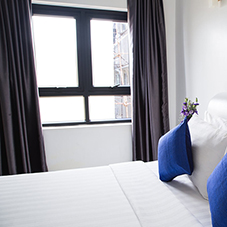In this third and final part of the introduction to automating windows we look at how to control actuators in order to offer building users the most flexible and sustainable methods of achieving the ultimate goal - good air quality.
The simplest method of control is by wiring actuators up to a single on / off switch which will offer either an open or closed window condition for one or many windows wired together. A more sophisticated, but still a simple solution, is to have the windows operable on a ‘rocker’ type switch. Windows will slowly open when pushed one way, slowly close when pushed the other, and when allowed to back to its central position the windows remain at the incremental position.
The adaptive natural ventilation control strategy monitors internal and external conditions and activates the vents or windows to provide a productive and efficient learning or working environment.
There may be a need to close the windows should it start to rain. A rain sensor can be fitted to the roof and when activated can ensure windows are safely closed to stop water ingress. Further options can include seven day timers which ensure windows are always closed for security outside normal room accommodation hours, such as in offices, schools, etc. For night time cooling or early morning purge time, clocks can be utilised to ensure that the automatic opening vents operate at the optimum time.
Cost effective sensors can be installed into areas where banks of windows have been automated and these same sensors can control proportional opening of windows to finely control comfort levels of temperature and CO2. Low levels of CO2 have been proven to be conducive to improved levels of concentration and learning, this is particularly important in schools.
Wind direction can contribute towards an effective ventilation strategy and with a ‘weather station’ installed on the roof of a building and more complex programmable controls, algorithms can be introduced which offer the most effective solutions by using wind driven ventilation strategies to control the comfort of an internal environment. Most importantly, window automation strategies must be combined with a buildings overall heating strategy, to maximise energy savings and offer the most sustainable solution. Early appointment of a window automation and ventilation specialist is imperative if the structure is to make best use of these options.
An entire window automation system can be linked so that it operates as a smoke ventilation system in case of a fire. Should this be the case, actuators will need to be 24 V DC instead of a directly connected to the mains power supply.
There are various standards that need to be adhered to ensure compliant installations; these include current building regulations and British Standards. However, new products standards are now being introduced from Europe for smoke control systems. The family of new standards fall under EN 12101 and covers ten parts of controlling smoke in a fire condition. For smoke ventilation the use of CE marked ventilators along with the requirements and testing methods are an important factor that specifications are requiring. A further important standard is EN 60335-2, which covers protection of the public where mechanical devices are present. Where mechanical automatic opening vents are operational under 2.5 metres (2.5 m from floor level) then protection against trapping is necessary.
The contractual process for installation of window automation and smoke control packages covers many on-site specialists, including the window manufacturer, installer, electrical systems, heating system, fire alarms, etc. So care in selecting a competent specialist that can offer a complete design solution all the way through to after care is crucial to getting a well-designed and integrated installation. Split packages where responsibility for different elements falls to different companies often lead to poorly designed, costly and inefficient systems.
The most cost efficient way of specifying and installing adaptive natural ventilation systems and smoke control systems is to approach a specialist who can offer a complete design package, from design through to installation and maintenance. At SE Controls the complete supply chain is supported, the main areas being; design & cost planning, approval and tendering process, coordination and commissioning handover, training and optimisation.
SE Controls operate across the globe with offices in several continents, with specialists offering clients expert advice based on local legislative requirements. Visit the website at www.secontrols.com for further information. To discuss your requirements with SE Controls, or request literature, please call their head office in Lichfield on 01543 443060.
Click here to read Why Automate Windows? Part 1: ‘Fresh Air & Actuators’
Click here to read Why Automate Windows? Part 2: ‘Window Orientation and Cabling’


![Communicating with specifiers & developing a personalised persona [EVENT] Communicating with specifiers & developing a personalised persona [EVENT]](/20/blogentry/00/04/48/th382.png)









